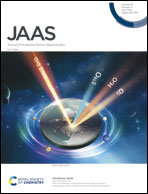In situ Fe isotopic analyses of fourteen reference materials using a synthetic Cr standard for mass bias and isobaric interference corrections by femtosecond LA-MC-ICP-MS†
Abstract
Highly precise and accurate measurements of Fe isotope ratios for fourteen reference materials from the USGS, MPI-DING and CGSG were successfully carried out using a developed analytical technique by fs LA-MC-ICP-MS. A synthetic standard, i.e., Cr-979S, was produced as a calibration standard for instrumental mass bias and isobaric interference corrections. The results for samples with low Cr concentration (54Cr/54Fe < 0.0001), e.g., δ56Fe values of BCR-2G (δ56Fe = 0.12 ± 0.10‰, 2SD, n = 15), were in excellent agreement with data from solution MC-ICP-MS within the measurement precision without the use of the Cr-979S standard. For the samples with high Cr concentration (54Cr/54Fe > 0.0001), e.g., BHVO-2G, δ56Fe values deviated from reference values when using the standard-sample bracketing method alone. Combining the standard-sample bracketing method with Cr-979S standard corrections and standard sample cone + H skimmer cone, the measured Fe isotopic compositions of GOR128-G and GOR132-G with extremely high Cr concentrations (54Cr/54Fe > 0.01) were identical to reference values within errors (δ56Fe = −0.01 ± 0.13‰, 2SD, n = 18; δ56Fe = 0.00 ± 0.13‰, 2SD, n = 13; respectively). A series of reference materials with varying Cr concentrations, including the USGS reference glasses (BCR-2G, BHVO-2G, BIR-1G, TB-1G, NKT-1G, GSD-1G and GSE-1G), MPI-DING reference glasses (KL2-G, ML3B-G, GOR128-G and GOR132-G) and CGSG reference materials (CGSG-1 and CGSG-4), were used to test our developed method of in situ Fe isotopic measurements using the combined standard-sample bracketing method and Cr-979S standard corrections by fs LA-MC-ICP-MS. All the reference materials yield relatively homogeneous Fe isotopic compositions with δ56Fe values ranging from −0.03‰ to 0.13‰ and δ56Fe reproducibility is below 0.15‰ (2SD), suggesting that the proposed isobaric interference correction and mass bias correction method is a useful tool for providing high-quality in situ Fe isotopic data of geological samples with both low and high Cr concentrations.



 Please wait while we load your content...
Please wait while we load your content...